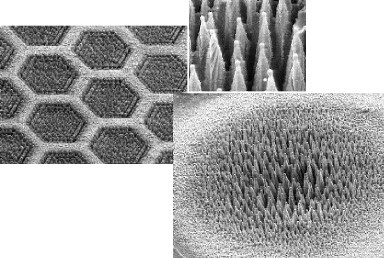Sometimes the most exciting scientific discoveries are made almost by accident. Researchers in the laboratory of Eric Mazur, McKay professor of applied physics and professor of physics, had been shining intense laser light on metal surfaces to study chemical reactions. One day Mazur decided that it was time to try something different. Why not expose a nonmetal semiconductor to the laser in the presence of a gas not naturally found in the atmosphere? A search in the lab's closets turned up a stack of old silicon wafers and a little bottle of gas labeled sulfur hexafluoridea leftover from an experiment 18 years before.
| Silicon normally reflects a great deal of visible light. But when hit with intense laser pulses in the presence of an inert gas, silicon turns black, its surface structurally altered so that it captures almost all light that strikes it. |
| Jim Harrison |
The researchers had stumbled onto something totally new: black silicon, a material so efficient at absorbing light that its potential for use in solar energy panels was immediately apparent to the world's leading manufacturer of raw material for solar cells. The Norwegian company flew a representative over to learn more about the substance, which traps 50 percent more visible light than regular silicon, a property that will prove valuable if the additional energy can be converted into a photocurrent.
But black silicon doesn't trap only visible light. For reasons that are not fully understood, the material shows gains in absorption across the light spectrum, especially in the infrared range. This has significant implications for telecommunications and even parts of the electronics industry, says Mazur. In their perpetual search for faster communications and faster processing, he notes, those industries are moving away from electronic signals to optical signalslight, after all, moves much faster than electricity. But at some point, the light must be converted back into an electrical signal. "That means you need to detect the optical signal," says Mazur. The telecommunications business has found that "the only way to communicate effectively over fiberoptic pathways is using infrared wavelengths." But that causes a big problem because regular silicona great detector of visible lightis blind in the infrared.
 |
| Clockwise from top: Spikes of black silicon seen at high magnification with a scanning electron microscope. Light is trapped and then absorbed by these structures. Spikes form in a circle only where the laser beam has struck the silicon's surface. Researchers can precisely control the laser to create honeycomb patterns of black silicon that could function like pixels in future display technologies. |
| Images courtesy Eric Mazur |
Not so black silicon, which is extremely sensitive to infrared wavelengths. "You can imagine taking an existing silicon chip that has processors and electronics and amplifiers on it," says Mazur, "and making a little part of it 'black,' so that the chip can seeyou give it eyes, so to speak, in the infrared."
Black silicon is also an extraordinary field emitterit can be induced to fire a stream of electrons at a nearby surface that has only a very small difference in potential voltagewhich may make it useful in the creation of portable displays for computers and other handheld devices. Displays currently on the market are inherently inefficient and by far the biggest drain on a portable's batteries; they create images by shining a light behind the entire screen surface, and then blocking some of it to create dark areas. Televisions, by contrast, light up only where an electron gun has excited phosphors on the surface of the picture tubeif you want black, you turn the gun off. The spikes on black silicon can be made to work like the electron gun in your television, turning on only where needed. "Black silicon," says Mazur, "keeps surprising us with new properties."
~Jonathan Shaw
Eric Mazur website:
https://mazur-www.harvard.edu/research/blacksilicon.html





